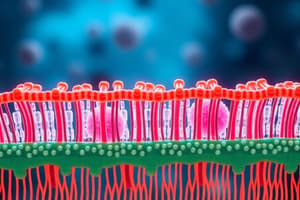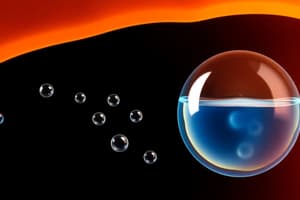Podcast
Questions and Answers
What is the substance that dissolves to make a solution called?
What is the substance that dissolves to make a solution called?
- Solvent
- Solution
- Mixture
- Solute (correct)
During diffusion, molecules tend to move _____?
During diffusion, molecules tend to move _____?
down the gradient
When the concentration of solute inside and outside a cell is the same, the cell has reached _____?
When the concentration of solute inside and outside a cell is the same, the cell has reached _____?
dynamic equilibrium
The diffusion of water across a selectively permeable membrane is called _____?
The diffusion of water across a selectively permeable membrane is called _____?
Energy for active transport comes from a cell's _____?
Energy for active transport comes from a cell's _____?
Transport that requires energy from ATP to move substances across the membrane is called passive transport.
Transport that requires energy from ATP to move substances across the membrane is called passive transport.
All of the following are kinds of passive transport EXCEPT?
All of the following are kinds of passive transport EXCEPT?
When molecules move down the concentration gradient, they are moving from _____?
When molecules move down the concentration gradient, they are moving from _____?
Active transport requires _____ to move molecules across the membrane.
Active transport requires _____ to move molecules across the membrane.
___ is the molecule that provides the energy for active transport.
___ is the molecule that provides the energy for active transport.
____ moves oxygen and carbon dioxide molecules from a high concentration to a low concentration.
____ moves oxygen and carbon dioxide molecules from a high concentration to a low concentration.
The cell organelles that burn glucose and provide ATP for active transport are the _____?
The cell organelles that burn glucose and provide ATP for active transport are the _____?
Water moves across the membrane by _____?
Water moves across the membrane by _____?
A small membrane sac used to transport substances during exocytosis and endocytosis is called a _____?
A small membrane sac used to transport substances during exocytosis and endocytosis is called a _____?
Passive transport requires energy.
Passive transport requires energy.
A cell placed in an _____ solution neither swells nor shrinks because the concentration of molecules outside the cell is the same as inside.
A cell placed in an _____ solution neither swells nor shrinks because the concentration of molecules outside the cell is the same as inside.
A solution in which there is a higher concentration of molecules outside the cell than inside is called _____?
A solution in which there is a higher concentration of molecules outside the cell than inside is called _____?
A concentration _____ forms whenever there is a difference in the concentration between one place and another.
A concentration _____ forms whenever there is a difference in the concentration between one place and another.
A solution in which the concentration of molecules outside the cell is lower than inside is called _____?
A solution in which the concentration of molecules outside the cell is lower than inside is called _____?
When molecules move from high to low along a concentration gradient, we say they are moving _____?
When molecules move from high to low along a concentration gradient, we say they are moving _____?
_____ pressure is caused by water inside a plant cell pushing against the cell.
_____ pressure is caused by water inside a plant cell pushing against the cell.
A solution with lower solute concentration (more water) is called _____?
A solution with lower solute concentration (more water) is called _____?
A solution in which the solute concentration is the same is called _____?
A solution in which the solute concentration is the same is called _____?
The condition plants require is _____?
The condition plants require is _____?
The condition that animal cells require is _____?
The condition that animal cells require is _____?
Red blood cells burst in a _____ solution.
Red blood cells burst in a _____ solution.
Plant cells shrink in a _____ solution.
Plant cells shrink in a _____ solution.
A solution with a higher solute concentration is called _____?
A solution with a higher solute concentration is called _____?
A solution with a high water concentration is called _____?
A solution with a high water concentration is called _____?
The transport protein that provides a tubelike opening in the plasma membrane through which particles can diffuse is called _____?
The transport protein that provides a tubelike opening in the plasma membrane through which particles can diffuse is called _____?
Energy is used during active transport but not passive transport.
Energy is used during active transport but not passive transport.
The process by which a cell takes in material by forming a vacuole around it is called _____?
The process by which a cell takes in material by forming a vacuole around it is called _____?
Particle movement from an area of higher concentration to an area of lower concentration is called _____?
Particle movement from an area of higher concentration to an area of lower concentration is called _____?
The process by which a cell expels wastes from a vacuole is called _____?
The process by which a cell expels wastes from a vacuole is called _____?
A form of passive transport that uses transport proteins is called _____?
A form of passive transport that uses transport proteins is called _____?
Particles movement from an area of lower concentration to an area of higher concentration is called _____?
Particles movement from an area of lower concentration to an area of higher concentration is called _____?
The transport protein that changes its shape when a particle binds with it is called _____?
The transport protein that changes its shape when a particle binds with it is called _____?
Two factors that affect the rate of diffusion are _____?
Two factors that affect the rate of diffusion are _____?
Flashcards are hidden until you start studying
Study Notes
Key Concepts in Cellular Transport
-
Solute: The substance that dissolves in a solution.
-
Diffusion: Molecules move down the concentration gradient from an area of high concentration to an area of lower concentration.
-
Dynamic Equilibrium: Achieved when the concentration of solute inside and outside a cell is equal.
-
Osmosis: The diffusion of water across a selectively permeable membrane.
-
Active Transport: A process that requires energy (ATP), primarily sourced from mitochondria, to move substances against their concentration gradient.
Types of Transport
- Passive Transport: Does not require energy and includes processes such as osmosis and diffusion.
- Facilitated Diffusion: A subtype of passive transport that utilizes transport proteins to help move particles.
Solutions and Their Effects
-
Isotonic Solution: Concentration of solutes is equal inside and outside the cell; cells neither swell nor shrink.
-
Hypertonic Solution: Higher concentration of solutes outside the cell; can cause cells to shrink (e.g., plant cells).
-
Hypotonic Solution: Lower concentration of solutes outside the cell; can lead to cell swelling or bursting (e.g., red blood cells).
Mechanisms of Cellular Transport
-
Mitochondria: Organelles that generate ATP, providing energy for active transport.
-
Vesicle: A small membrane sac used during processes like endocytosis (substance intake) and exocytosis (substance expulsion).
Concentration Gradient
- A concentration gradient forms when there is a difference in solute concentration between two areas, driving the movement of molecules from high to low concentration.
Pressure and Cell Conditions
-
Osmotic Pressure: Generated by water inside a plant cell pressing against the cell wall.
-
Plant cells thrive in a hypotonic environment, requiring more water, while animal cells fare better in isotonic environments.
Key Terms in Transport Proteins
-
Channel Protein: A transport protein that allows molecules to diffuse across the plasma membrane via a tubelike opening.
-
Carrier Protein: A type of transport protein that changes shape when a particle binds to it, facilitating active or passive transport.
Factors Influencing Diffusion
- The rate of diffusion is affected by the amount of solute and temperature, impacting how quickly molecules spread out.
Studying That Suits You
Use AI to generate personalized quizzes and flashcards to suit your learning preferences.




